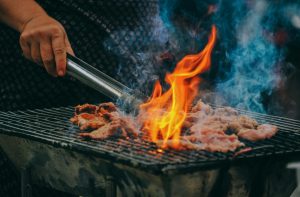The Most Dangerous Things You Can Do With Food at a Cook Out
Posted in Our Blog on July 2, 2024

With July 4th rapidly approaching everyone is already in huge debate about how they want to celebrate. My personal favorite way to celebrate this important American holiday is with a cook out. Read today to find out the most dangerous things you can do with food at a cook out and how to make sure everyone leaves happy, healthy and stuffed to the gills from amazing food.
Peak times of foodborne illness include the months July and August. Dennis D’Amico, an associate professor in the department of animal science at the University of Connecticut said “This is the time of year associated with increased cases of listeriosis, campylobacteriosis, salmonellosis and Shiga toxin-producing Escherichia coli infections.” What causes this and how can we prevent it?
Food scientist Bryan Quoc Le explained it this way: “As temperatures become warmer, the rate at which microorganisms grow speeds up. While most spoilage and pathogenic microorganisms have very slow growth rates at refrigerator temperatures, they accelerate to 10 to 100 times the growth rate per hour at temperatures that reach 80°F to 85°F. That means the number of bacteria that can cause food poisoning will double at a much greater speed.”
Top Dangers & How to Avoid Them:
- Undercooking Meat— People often do not use a proper meat thermometer which is a huge no go when it comes to cooking meat but especially at a cook out. Poultry is a huge culprit when it comes to foodborne illness at a cook out. Meats must be cooked to the proper internal temperature and verified using a food thermometer.” Ground meats must be cooked to 160°F, chicken to 165°F and fresh steaks and chops to 145°F. When the meat is cooked, don’t put it back on a plate that still has juices from the raw meat, Morris said. “Even though the meat is cooked, you can re-contaminate it with bad bacteria from raw meat and poultry juices that linger on a platter.”
- Keeping Food Out Too Long— Think 40 degrees to 140 degrees. “Food that needs to stay cold needs to remain below 40°F, with plenty of ice and proper insulated storage, like coolers and Styrofoam chests,” Le said. “Food that has been warmed up should be kept over 140°F. You can keep it warm using the side of the grill rack or an alcohol burner.” Leave food out no more than 2 hours which will give guests plenty of time to enjoy but not too much time so that anyone runs the risk of becoming sick.Le explained why: “Bacteria can divide at room temperature every 15 to 20 minutes. So one single pathogenic bacteria can become 16 within the first hour, 256 in the second hour and over 4,000 in the third hour. Some species and strains can multiply at an even faster rate, depending on conditions in the food.”Depending on the toxins produced by the bacteria, some microorganisms can cause food poisoning with as little as 10 individual bacteria cells, while others require hundreds or thousands in number to cause sickness, Le said. If you’re more vulnerable, the risk is greater, and he noted that children, pregnant women and elderly individuals can have a weaker immune system that might be more severely affected by contaminated food.
“Listeria monocytogenes can cause additional complications in pregnant women, and listeriosis can induce abortion, stillbirth, or meningitis in newborn babies,” he said.
- Watch Your Deli Salads— Anything that contains eggs and mayonnaise such as egg salad, devilled eggs and potato salad can become a huge risk. These are a major concern because eggs can be contaminated with the bacteria Salmonella or Campylobacter, which can cause serious illness. This includes both homemade and store purchased salads. “They’re popular during the summer, but there’s a concern due to potential contamination with Listeria monocytogenes,” he said. “This bacterium can be found in processing and deli environments and can contaminate prepared foods and their ingredients. Listeria can grow in the cold, so if a food is contaminated [with] Listeria, its numbers can increase even during cold storage at the deli.”
- Check Your Cooler— We always have a packed cooler of ice at every event we host. Not only does it help with keeping our beverages cold but we have a separate cooler for cold foods especially when traveling. We use ice packs and regular ice as well. Why separate the drinks and the food? We learned years ago that the drink cooler gets opened way more than the food cooler. This prevents an accident like leaving the cooler open and allowing the ice to melt in the food cooler.
- Don’t Reuse Ice— Ice that you drink with does not need to come from the cooler, especially the one that is holding food. Dangerous juices especially from meats can contaminate the ice and make for a really sketchy situation. We like to pack Ziploc bags with “drink ice” separately and put that into the drink cooler. It takes a couple extra seconds but between clean ice and a clean drinking cup a lot of sickness can be avoided.
At the end of the day we wish everyone a happy and healthy cook out season and don’t forget to follow MakeFoodSafe for many food safety articles and tips this grilling season.
By: Samantha Cooper